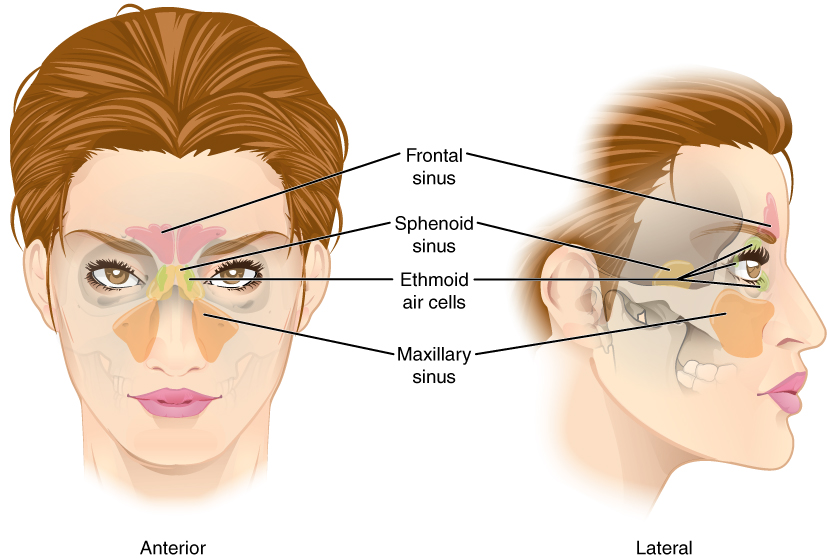Respiratory System(4)
1. Nose :- Common cold and Flu ( Part 2)
Treatment :-
A. Asking :-
You must know the following information before starting OTC treatment
1. Age :-
- approximative age of patient
- child or adult or elderly
- Age affects the following
1. choice of suitable treatment
2. choice of suitable dose
3. choice of suitable dosage form
- children more susceptible to respiratory infections
- elderly and above 65 years ............. at risk
2. Onset of symptoms :-
- Rapid onset means Flu (influenza )
- Gradual symptoms means Common cold
3. Runny or Blocked Nose:-
- Runny nose ........... occurs at first days
- start with rhinorrhea and clear watery fluid
- then ........ production of thick mucous and may be purulent
- Blocked ............. Occurs due to vasodilation of blood vessels in nasal mucosa and swelling of leaning surface and production of thick mucous discharge
- Clear nose ......... most common in flu
4. Summer cold :-
- Flu and common colds more common in winter months
- summer symptoms as
1. Congestion
2. Sneezing
3. Irritant watery eyes
( more likely due to Allergic Rhinitis not a common cold or Flu)
5. Sneezing /Cough:-
- Occur due to inflammation and congestion of nasal passages and sinuses
- pain above or blow eyes due to Sinusitis
- Patients with Flu having
1. more headache and pain
2. more muscle and joints pain
7. High temperature:-
- Common cold ................. Low grade fever
- Flu .............. High grade fever ( 37,9- 38,9 c )
8. Sore throat:-
- feels dry and sore
- More common in Colds than Flu
- sometimes be the FIRST symptom of Common Cold
9. Earache :-
- common complication of common cold
- indicates .......... Otitis media
- Especially in children
- occur due to blocking of Eustachein tube ( connect between middle ear and nose )
10. Facial pain and frontal headache :-
- strongly indicates Sinusitis ( next topic )
11. History :-
- Ask about the following :-
1. Medications ( to avoid interactions with OTC drugs )
2. Diseases ( CVS, Diabetes , CNS , Liver, Renal )
B. Refer :-
When to refer to physician :-
Fever more than 38.9 C
Elderly ( age above than 65 years )
Infants ( less than 9 months )
Chest pain
Earache
Asthma
Concurrent diseases
C. Non-Pharmacological Treatment :-
- Increase fluid intakes
- Bed rest
- Good nutrition
- Using of humidifier or vaporizer ( steam )
- Using of tea, lemon , honey , orange , soaps
D. PHARMACOLOGICAL TREATMENT:-
Most products of common cold and flu available in market present in a combination of two or three of the following categories :-
- Decongestant
- Antihistamines
- Analgesic and Antipyretics
- Vitamin c
Other medication can be used as ;-
Cough Products
Antibiotics ( complications )
Antivirals
Vaccines
1. Decongestant:-
A. Action:-
Used to relieve congestion by blood vessels vasocostriction and decrease edema
B. Classification :-
3 types of decongestant present :-
Direct Decongestant ( acts directly on receptors):-
- phenylephrine
- oxymetazoline
- tetrahydrozoline
2. Indirect :-
Decongestant available as OTC treatment :-
- Systemic Decongestant :-
- phenylephrine
- pseudoephedrine
A. Short Acting :-
- ephedrine
- epinephrine
- naphazoline
- phenylephrine
- propyl hexidine
- tetrahydrozoline
B. Intermediate Acting :-
C. Dose of Decongestant :-
|
No.
|
Drug
|
Dose
per day
|
|
Systemic
decongestant
|
|
Age
|
Above
12 years
|
6 –
12
|
2
- 6
|
|
1
|
Phenylephrine.
HCL
|
60
mg
|
5
mg
|
2,5
mg
|
|
2
|
Phenyehrine
bitartarate
|
62
mg
|
7.8
mg
|
No
|
|
3
|
Pseudoephedrine
|
240
mg
|
30
mg
|
15
mg
|
|
Topical
decongestant
|
|
1
|
Ephedrine
0.5 %
|
2 –
3 drops
|
1 –
2 drops
|
No
|
|
2
|
Naphazoline
0.5 % 0.025 %
|
2 –
3 drops
|
1 –
2 drops
|
No
|
|
3
|
Oxymetazoline
0.5 % 0.025 %
|
2 –
3 drops
|
1 –
2 drops
|
No
|
|
4
|
Phenylephrine
1% 0,5 %
|
2 –
3 drops
|
1 –
2 drops
|
No
|
|
5
|
Xylometazoline
0.1 % 0.05%
|
2 –
3 drops
|
1 –
2 drops
|
No
|
D. Over dose of decongestant :-
causes 1. CNS Stimulation
2. CVS Collapse
3. Shock
4. Coma
E. Side effects of Decongestant :-
1. CVS ( elevated blood pressure, tachycardia )
2. CNS ( restlessness, insomnia, hallucination)
3. side effects more common in systemic than topical products
G. Duration of therapy:-
1. 3- 5 days are the accepted duration of therapy to avoid rebound congestion
2. treatment of rebound congestion :-
- withdrawal of topical decongestant
- replace with nasal saline
- use systemic decongestant
- using of topical hydrocortisone
- mucosa will return to normal within 1 - 2 weeks
H. Contraindications :-
- hypertension
- diabetes
- hyperthyroidism
- coronary heart disease
- prostatic hyperatrophy
- increased intra-ocular pressure (glaucoma )
I. Drug interactions :-
- patients receive MAOIs as
1. tranylcypromine ( parentil 10 mg )
TCAS ( amytriptyline)
betablockers
other treatment and market products ....................... NEXT TIME
THANKS
MILAD REDA
